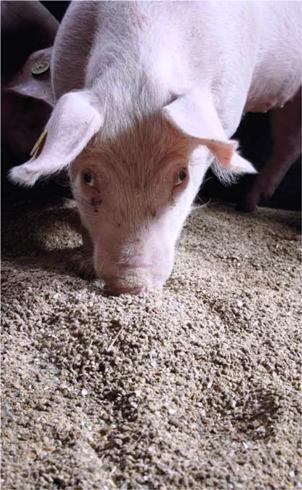Challenges of feeding pigs in a changing marketplace

We can learn a great deal from history. Mick Hazzeldine of Premier Nutrition in a presentation at the 22nd JSR Technical conference went back to 1976 to remind the audience of UK pig production some 35 years ago. He also highlighted current challenges and obstacles.
UK pig meat production in 35 years has dropped from 826,000 tonnes to 775,000 tonnes despite a substantial rise in carcass weight (61.9kg to 78.4kg), allied to a massive decline in abattoirs (1161 vs. 124) and high street butchers (25,300 vs. 6,800). In comparison: poultry meat production far more industrialised and tripled from 590,000 tonnes to 1.56 million tonnes in that period. Interestingly though the price ration pig/wheat has not changed that much. It was 1.04 in 1976 and 1.07 in 2010. In terms of raw materials, in 1976 UK producers fed manioc, meat and bone meal and fishmeal. In 2011 the focus is on biscuit meal, soya 48 and 00-rapeseed meal. There have been big changes in feed additives. In 1976 we had AGPs, Maxymin (to reduce back fat) plus high levels of copper, whereas in 2010 we still have zinc oxide plus enzymes, acids and probiotics.
Raw materials, however, are much better defined than they were 35 years ago. Back then we used TDN and NE and formulated to 5 amino acids, total Phosphorus or available P and Crude Fibre. Now 35 years on we use NE, work with 9 SID amino acids, digestible P and NDF.
Raw materials
When looking at fishmeal, the availability has substantially reduced with 61% now going to aquaculture and of the current available 5 million tonnes, 1.6 million tonnes is going to China. Quality is variable and Hazzeldine suggested that a £6 (€7.20) inclusion of fishmeal in a 13-35kg diet could be better spent elsewhere. “How times change. In the 1960s often 10% fishmeal was included even in finisher diets, although with the caution that it might result in “fishy bacon”. Wheat was not recommended, because of worries about it forming a dough in the pig’s stomach and causing serious digestive upsets,” Hazzeldine recalled.
When looking at fishmeal, the availability has substantially reduced with 61% now going to aquaculture and of the current available 5 million tonnes, 1.6 million tonnes is going to China. Quality is variable and Hazzeldine suggested that a £6 (€7.20) inclusion of fishmeal in a 13-35kg diet could be better spent elsewhere. “How times change. In the 1960s often 10% fishmeal was included even in finisher diets, although with the caution that it might result in “fishy bacon”. Wheat was not recommended, because of worries about it forming a dough in the pig’s stomach and causing serious digestive upsets,” Hazzeldine recalled.
He also remembered that as a pig unit manager in the early 1970s he was formulating the unit’s home mixed diets. He happened to do a check and found that by mistake the finishing diet contained 40% wheat – unheard of in those days. He was very relieved that no pigs suffered and had the diets corrected, with barley in place of wheat, as was considered the norm in those days.Hay fever sufferers are only too aware of the massive quantity of rape that is now grown in the UK – in May the countryside is a mass of yellow. In the past Anti-Nutritional Factors (ANFs) limited inclusion levels but today with zero and double zero rape varieties the amounts of glucosinolates and erucic acid have been reduced by 90%. “Rapeseed meal is by far our most important home-produced protein. It isn’t what it used to be plus we don’t formulate the way we used to,” Hazzeldine said.
Glucosinates have been reduced from 120-150 µmols in traditional rape seed to 10-15 µmols in 00-rape seed today. And in poultry there are now brown egg layers that don’t convert sinapines in rapeseed to TMA (trymethilamine) which causes a fishy taint of the eggs.Typical inclusion rates of rapeseed are 5% in grower diets; 10-15% in finishers and 7% in sow diets. This reduces the risk and reliance from “all soya” plus saves money, typically 30-50p (36-60 €c) per percentage included. Rape has a 70% trigger price vs soya. Assuming soya is £285 (€342)/tonne, then rape has a replacement value of £200 (€240)/tonne. If rape is priced at £165 (€198)/tonne, there is a saving of £35 (€42)/tonne or 35p (42€c)/% inclusion.
On field beans Hazzeldine commented that there has been a slight increase in the surface grown, with 4% being used when priced at £190/tonne increasing to 10% when beans cost £170/tonne. Peas are not available in high amounts. The area grown in the UK is declining and mostly rejected peas bound for human consumption are used in pig rations. With the growth of the biofuel industry more derivatives of this sector become available. In the UK two ethanol plants have come into production together using 1 million tonnes of wheat and producing a third of ethanol, DDGS and carbon dioxide. DDGS has around 33% protein but with low amino acid concentrations. There is a large variation between plants but early indications are low variability within a plant. In the US inclusion rates of 30-40% are known, but in the UK 4% is added when priced £190/t and 10% at £170/t. “DDGS is worth more in cattle feed than in pigs,” Hazzeldine added. From the biodiesel industry limited amounts of expeller rapeseed meal and glycerol are available to the feed industry. “We still don’t fully understand the energy content of cereals, where wheat takes up 55-60% of the energy in finishing feeds and barley circa 20%. There can be so much variation caused by type of wheat (hard/soft), grist, fibre, starch, viscosity, rye gene and varieties, pellets vs meal, enzymes, farm driers, etceteras,” Hazzeldine said.
How low to go?
Expanding human population and biofuels may result in by-products again being relatively cost effective i.e. DDGS, wheatfeed, rapeseed meal. It seems like the cost of fats will remain very high so we may therefore need to consider feeds of lower nutrient density. With finishing pigs, as nutrient density drops, FCR worsens, as does growth rate. For example, 1 MJ DE/kg gives a change of 0.2 FCR. Feed conversion and therefore cost/kg LW gain is predictable in finishing pigs. How does the weight of the pig influence to what extent we can reduce nutrient density? In other words, how low can we go?
Expanding human population and biofuels may result in by-products again being relatively cost effective i.e. DDGS, wheatfeed, rapeseed meal. It seems like the cost of fats will remain very high so we may therefore need to consider feeds of lower nutrient density. With finishing pigs, as nutrient density drops, FCR worsens, as does growth rate. For example, 1 MJ DE/kg gives a change of 0.2 FCR. Feed conversion and therefore cost/kg LW gain is predictable in finishing pigs. How does the weight of the pig influence to what extent we can reduce nutrient density? In other words, how low can we go?
Growth rate tends to decline as we reduce nutrient density. The decline is relatively small (say 10-25g/day) when feeds are >13 MJ DE/kg and the pigs are above about 65kg; the younger the pig the greater the hit. Grading improves but killing out % gets poorer. Also, if nutrient density is reduced, N excretion will increase. 1% crude protein = 10% N excretion. Additionally, water intake increases as does manure production.











